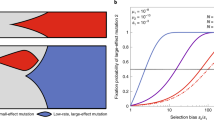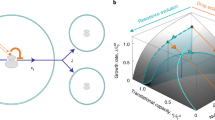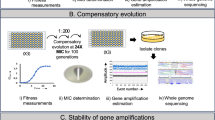Abstract
Evolutionary trajectories are constrained by trade-offs when mutations that benefit one life history trait incur fitness costs in other traits. As resistance to tetracycline antibiotics by increased efflux can be associated with an increase in length of the Escherichia coli chromosome of 10% or more, we sought costs of resistance associated with doxycycline. However, it was difficult to identify any because the growth rate (r), carrying capacity (K) and drug efflux rate of E. coli increased during evolutionary experiments where the species was exposed to doxycycline. Moreover, these improvements remained following drug withdrawal. We sought mechanisms for this seemingly unconstrained adaptation, particularly as these traits ought to trade-off according to rK selection theory. Using prokaryote and eukaryote microorganisms, including clinical pathogens, we show that r and K can trade-off, but need not, because of ‘rK trade-ups’. r and K trade-off only in sufficiently carbon-rich environments where growth is inefficient. We then used E. coli ribosomal RNA (rRNA) knockouts to determine specific mutations, namely changes in rRNA operon (rrn) copy number, than can simultaneously maximize r and K. The optimal genome has fewer operons, and therefore fewer functional ribosomes, than the ancestral strain. It is, therefore, unsurprising for r-adaptation in the presence of a ribosome-inhibiting antibiotic, doxycycline, to also increase population size. We found two costs for this improvement: an elongated lag phase and the loss of stress protection genes.
This is a preview of subscription content, access via your institution
Access options
Access Nature and 54 other Nature Portfolio journals
Get Nature+, our best-value online-access subscription
$29.99 / 30 days
cancel any time
Subscribe to this journal
Receive 12 digital issues and online access to articles
$119.00 per year
only $9.92 per issue
Buy this article
- Purchase on Springer Link
- Instant access to full article PDF
Prices may be subject to local taxes which are calculated during checkout







Similar content being viewed by others
References
Herron, M. D. & Doebeli, M. Parallel evolutionary dynamics of adaptive diversification in Escherichia coli . PLoS Biol. 11, e1001490 (2013).
Maharjan, R. et al. The form of a trade-off determines the response to competition. Ecol. Lett. 16, 1267–1276 (2013).
Ben-Hur, E., Fragman-Sapir, O., Hadas, R., Singer, A. & Kadmon, R. Functional trade-offs increase species diversity in experimental plant communities. Ecol. Lett. 15, 1276–1282 (2012).
Kraaijeveld, A. R. & Godfray, H. C. Trade-off between parasitoid resistance and larval competitive ability in Drosophila melanogaster . Nature 389, 278–280 (1997).
Fine, P. V. A. et al. The growth-defense trade-off and habitat specialization by plants in Amazonian forests. Ecology 87, S150–S162 (2006).
Dieckmann, U. & Doebeli, M. On the origin of species by sympatric speciation. Nature 400, 354–357 (1999).
Calsina, A. & Cuadrado, S. Small mutation rate and evolutionary stable strategies in infinite dimentional adaptive dynamics. Math. Biol. 48, 135–159 (2004).
Metz, J. A. J., Geritz, S. A. H., Meszena, G., Jacobs, F. J. A. & Van Heerwaarden, J. S. in Stochastic and Spatial Structures of Dynamical Systems (eds van Strien, S. J. & Verduyn Lunel, S. M. ) 183–231 (North Holland, 1996).
Gudelj, I., Coman, C. D. & Beardmore & R. E. Classifying the role of trade-offs in the evolutionary diversity of pathogens. Proc. R. Soc. A 426, 97–116 (2006).
Meyer, J. R., Gudelj, I. & Beardmore, R. Biophysical mechanisms that maintain biodiversity through trade-offs. Nat. Commun. 6, 6278 (2015).
Beardmore, R. E., Gudelj, I., Lipson, D. A. & Hurst, L. D. Metabolic trade-offs and the maintenance of the fittest and the flattest. Nature 472, 342–346 (2011).
Reznick, D., Nunney, L. & Tessier, A. Big houses, big cars, superfleas and the costs of reproduction. Trends Ecol. Evol. 15, 421–425 (2000).
Leiby, N. & Marx, C. J. Metabolic erosion primarily through mutation accumulation, and not tradeoffs, drives limited evolution of substrate specificity in Escherichia coli . PLoS Biol. 12, e1001789 (2014).
Lipson, D. A. The complex relationship between microbial growth rate and yield and its implications for ecosystem processes. Front. Microbiol. 6, 615 (2015).
Mueller, L. D. & Ayala, F. J. Trade-off between r-selection and k-selection in Drosophila populations. Proc. Natl Acad. Sci. USA 78, 1303–1305 (1981).
Sibly, R. M. & Hone, J. Population growth rate and its determinants: an overview. Phil. Trans. R. Soc. Lond. B 357, 1153–1170 (2002).
Luckinbill, L. S. r and K selection in experimental populations of Escherichia coli . Science 202, 1201–1203 (1978).
Luckinbill, L. S. Selection and the r/K continuum in experimental populations of protozoa.. Am. Nat. 113, 427–437 (1979).
Nilsson, A. I. et al. Reducing the fitness cost of antibiotic resistance by amplification of initiator tRNA genes. Proc. Natl Acad. Sci. USA 103, 6976–6981 (2006).
Millan, A. S. et al. Positive selection and compensatory adaptation interact to stabilize non-transmissible plasmids. Nat. Commun. 5, 5208 (2014).
Blair, J. M. A. et al. AcrB drug-binding pocket substitution confers clinically relevant resistance and altered substrate specificity. Proc. Natl Acad. Sci. USA 112, 3511–3516 (2015).
Stearns, S. The Evolution of Life Histories (Oxford Univ. Press, 1992).
Aktipis, C. A., Boddy, A. M., Gatenby, R. A., Brown, J. S. & Maley, C. C. Life history trade-offs in cancer evolution. Nat. Rev. Cancer 13, 883–892 (2013).
Korolev, K. S., Xavier, J. B. & Gore, J. Turning ecology and evolution against cancer. Nat. Rev. Cancer 14, 371–380 (2014).
Pfeiffer, T., Schuster, S. & Bonhoeffer, S. Cooperation and competition in the evolution of ATP-producing pathways. Science 292, 504–507 (2001).
Novak, M., Pfeiffer, T., Lenski, R. E., Sauer, U. & Bonhoeffer, S. Experimental tests for an evolutionary trade-off between growth rate and yield in E. coli . Am. Nat. 168, 242–251 (2006).
Wong, W. W., Tran, L. M. & Liao, J. C. A hidden square-root boundary between growth rate and biomass yield. Biotechnol. Bioeng. 102, 73–80 (2009).
Fitzsimmons, J., Schoustra, S., Kerr, J. & Kassen, R. Population consequences of mutational events: effects of antibiotic resistance on the r/k trade-off. Evol. Ecol. 24, 227–236 (2010).
Mori, M., Hwa, T., Martin, O. C., De Martino, A. & Marinari, E. Constrained allocation flux balance analysis. PLoS Comput. Biol. 12, e1004913 (2016).
Stearns, S. C. The evolution of life history traits: a critique of the theory and a review of the data. Annu. Rev. Ecol. Syst. 8, 145–171 (1977).
Monod, J. The growth of bacterial cultures. Annu. Rev. Microbiol. 3, 371–394 (1949).
Roughgarden, J. Density-dependent natural selection. Ecology 52, 453–468 (1971).
Boyce, M. S. Restitution of r- and k-selection as a model of density-dependent natural selection. Annu. Rev. Ecol. Syst. 15, 427–447 (1984).
MacLean, R. C. & Gudelj, I. Resource competition and social conflict in experimental populations of yeast. Nature 441, 498–501 (2006).
Koch, A. R. & Deppe, C. S. In vivo assay of protein synthesizing capacity of Escherichia coli from slowly growing chemostat cultures. J. Mol. Biol. 55, 549–562 (1971).
Stevenson, B. S. & Schmidt, T. M. Growth rate-dependent accumulation of RNA from plasmid-borne rRNA operons in Escherichia coli . J. Bacteriol. 180, 1970–1972 (1998).
Fuentes-Hernandez, A. et al. Using a sequential regimen to eliminate bacteria at sublethal antibiotic dosages. PLoS Biol. 13, e1002104 (2015).
Chopra, I. & Roberts, M. Tetracycline antibiotics: mode of action, applications, molecular biology, and epidemiology of bacterial resistance. Microbiol. Mol. Biol. Rev. 65, 232–260 (2001).
Wang, X. et al. Cryptic prophages help bacteria cope with adverse environments. Nat. Commun. 1, 147 (2010).
Laehnemann, D. et al. Genomics of rapid adaptation to antibiotics: convergent evolution and scalable sequence amplification. Genome Biol. Evol. 6, 1287–1301 (2014).
Quinlan, A. R. & Hall, I. M. BEDTools: a flexible framework for comparing genomic features. Bioinformatics 26, 841–842 (2010).
Acknowledgements
The rrn knockout strains derived from E. coli MG1655 were gifted by T. Bollenbach, strain AG100 was provided by S. Levy and Candida strains were a gift from S. Bates, who are sincerely thanked for their help.
Author information
Authors and Affiliations
Contributions
R.B., I.G., M.H. and C.R.R. proposed research questions and hypotheses, and subsequently designed the experiments; R.B., C.R.R., F.G. and M.H. designed and wrote computer codes to analyse the data; C.R.R., M.H. and S.D. performed the experiments; and R.B., C.R.R. and I.G. wrote the manuscript.
Corresponding author
Ethics declarations
Competing interests
The authors declare no competing financial interests.
Supplementary information
Supplementary information
Supplementary Figures 1–15; Supplementary Tables 1,2 (PDF 1191 kb)
Rights and permissions
About this article
Cite this article
Reding-Roman, C., Hewlett, M., Duxbury, S. et al. The unconstrained evolution of fast and efficient antibiotic-resistant bacterial genomes. Nat Ecol Evol 1, 0050 (2017). https://doi.org/10.1038/s41559-016-0050
Received:
Accepted:
Published:
DOI: https://doi.org/10.1038/s41559-016-0050
This article is cited by
-
Relationships between intrinsic population growth rate, carrying capacity and metabolism in microbial populations
The ISME Journal (2023)
-
Inferring density-dependent population dynamics mechanisms through rate disambiguation for logistic birth-death processes
Journal of Mathematical Biology (2023)
-
Can Antibiotic Resistance Genes in Household Food Waste be Reduced by Earthworm Vermicomposting? Underpinning Mechanisms and Strategies
Reviews of Environmental Contamination and Toxicology (2023)
-
Predicting the re-distribution of antibiotic molecules caused by inter-species interactions in microbial communities
ISME Communications (2022)
-
Tumour heterogeneity and the evolutionary trade-offs of cancer
Nature Reviews Cancer (2020)



